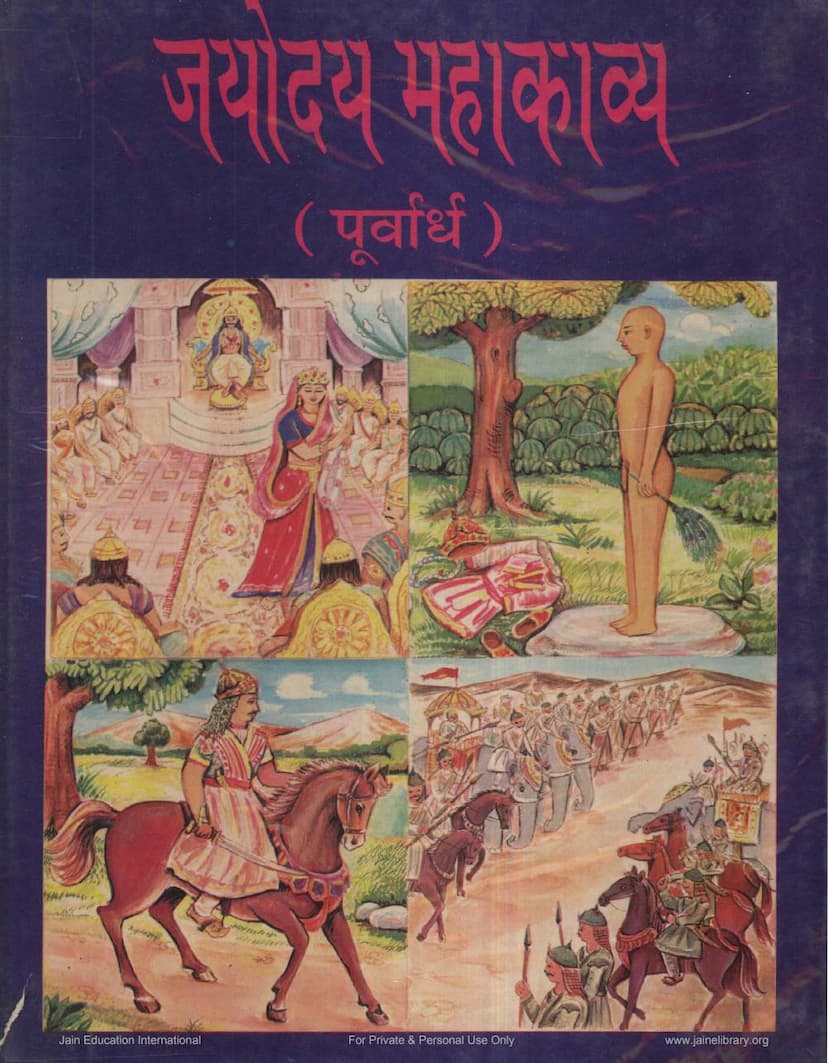Jayodaya Mahakavya Purvardha
Added to library: September 2, 2025

Summary
This is a comprehensive summary of the provided Jain text, "Jayodaya Mahakavya Purvardha," based on the translated content from the catalog link.
Book Title: Jayodaya Mahakavya Purvardha (जयोदय महाकाव्य - पूर्वार्ध) Author: Bhuramal Shastri (Bhūramal Shāstrī) Publisher: Digambar Jain Samiti evam Sakal Digambar Jain Samaj, Ajmer (राज.) Catalog Link: https://jainqq.org/explore/002756/1
Summary:
The "Jayodaya Mahakavya Purvardha" is a significant Jain epic poem, authored by the esteemed scholar Bhuramal Shastri, who later became Muni Gyansagar. The text, published by the Digambar Jain Samiti and the entire Digambar Jain Samaj of Ajmer, is dedicated to Acharya Shri Vidyasagar Ji Maharaj and his disciple Muni Shri Sudhasagar Ji Maharaj.
The provided text appears to be the preliminary section (Purvardha) of a larger work, focusing on the life and philosophy of the author himself, particularly his transformation and contributions to Jain literature and spirituality.
Key Aspects and Themes:
- The Author's Life Journey (Acharya Gyansagar Ji Maharaj): The initial pages detail the life of Bhuramal Shastri, who later became Acharya Gyansagar Ji Maharaj. It covers his humble beginnings, his intense desire for knowledge, his academic pursuits in Varanasi, and his eventual renunciation of worldly life. His journey includes becoming a Shastri, adhering to Brahmacharya, taking the Saptam Pratima vows, becoming a Kshullak (Gyanbhushan), and finally receiving Muni Diksha as Muni Gyansagar. He is highlighted as the first disciple of Acharya Shivsagar Ji Maharaj.
- Literary and Philosophical Contributions: Bhuramal Shastri (Gyansagar) was a prolific writer and poet, renowned for keeping the tradition of Sanskrit Mahakavya alive in the modern era. The text mentions his literary works like "Dayodaya," "Bhadrodaya," "Virodaya," and "Sudarshanodaya." His deep study of foundational Jain scriptures like Dhaval, Mahadhaval, Jaydhaval, and Mahabandh is also noted.
- Spiritual Lineage and Mentorship: The text emphasizes the spiritual lineage, starting from Acharya Om Shanti Sagar Ji Maharaj, followed by Acharya Veer Sagar Ji and Acharya Shiv Sagar Ji. The narrative highlights the profound impact of Muni Gyansagar's teachings and guidance on his disciples, particularly Muni Vidyasagar Ji Maharaj, who is portrayed as an exceptionally capable and devoted disciple. The text also celebrates Muni Sudhasagar Ji Maharaj, a prominent disciple of Acharya Vidyasagar Ji Maharaj, and the occasion of his Chaturmas in Ajmer in S.Y. 1994, which led to this publication.
- The "Jayodaya Mahakavya": The book itself, "Jayodaya Mahakavya," is a significant literary creation by Bhuramal Shastri. The summary indicates that the text details the content of the first thirteen chapters (Sargas) of this epic poem, focusing on the valor, virtues, and righteous actions of a king named Jayakumar. The narrative covers his life from his early days, his encounter with a muni, his understanding of Jain principles, his participation in a swayamvar, his marriage, and his administrative duties.
- Promotional and Dedicatory Aspects: The publication is presented with immense respect and reverence for the Acharyas and Munis. It details the publication committee, editors, and contributors, acknowledging their efforts in bringing this profound work to the public. The dedication highlights the efforts of various trusts and individuals in making Jain scriptures accessible for self-study.
- Key Events and Details: The text mentions specific events like the 1994 Chaturmas of Muni Sudhasagar Ji Maharaj in Ajmer, the historical significance of Soni Ji ki Nasian, and the publication being the second edition. It also notes that the book is available for study and can be obtained by sending postage.
Content of the Mahakavya (as outlined in the text):
The summary provides a chapter-wise breakdown of the "Jayodaya Mahakavya (Purvardha)":
- First Chapter: Glorifies the immense valor of Jayakumar, the chief general of the first emperor Bharat Chakravarti and ruler of Hastinapur. It mentions his encounter with a muni and seeking guidance.
- Second Chapter: Details the muni's sermon on the importance of Grihastha Dharma, including Nischay (ultimate truth) and Vyavahar (conventional truth) naya. It also describes an incident involving a serpent, its karmic retribution, and the resulting enlightenment of Jayakumar.
- Third Chapter: Describes Jayakumar's journey to Kashi for the swayamvar of Princess Sulochana, daughter of King Akampana. It covers the welcome and arrangements made for him.
- Fourth Chapter: Mentions the arrival of Arkeerti, son of Bharat Chakravarti, also a contender for Sulochana's hand.
- Fifth Chapter: Elaborates on the swayamvar ceremony and Sulochana's selection of Jayakumar. It also includes descriptions of the preparations and the gathering of kings.
- Sixth Chapter: Narrates the ensuing conflict after Jayakumar's victory and Arkeerti's subsequent remorse and reconciliation.
- Seventh Chapter: Details Jayakumar's acceptance of Sulochana's hand and the preparations for the wedding, including the arrival of guests.
- Eighth Chapter: Recounts the battlefield descriptions, the courage of the warriors, and the symbolic representations within the chaos of war.
- Ninth Chapter: Focuses on the internal thoughts and deliberations of the characters, particularly the ruler Akampana, regarding Jayakumar's valor and the political implications.
- Tenth Chapter: Describes the wedding ceremonies, the bride's beauty and its impact, and the various aspects of hospitality.
- Eleventh Chapter: Continues the narrative with descriptions of the city, the divine influences, the characters' reactions, and the blessings received.
Overall Significance:
The "Jayodaya Mahakavya Purvardha" is presented as a work of profound literary merit and spiritual significance, celebrating Jain principles, the lives of great souls, and the pursuit of righteousness. It serves as a testament to the author's deep scholarship and devotion to the Jain tradition. The text also reflects the reverence and respect the Jain community holds for its spiritual leaders.